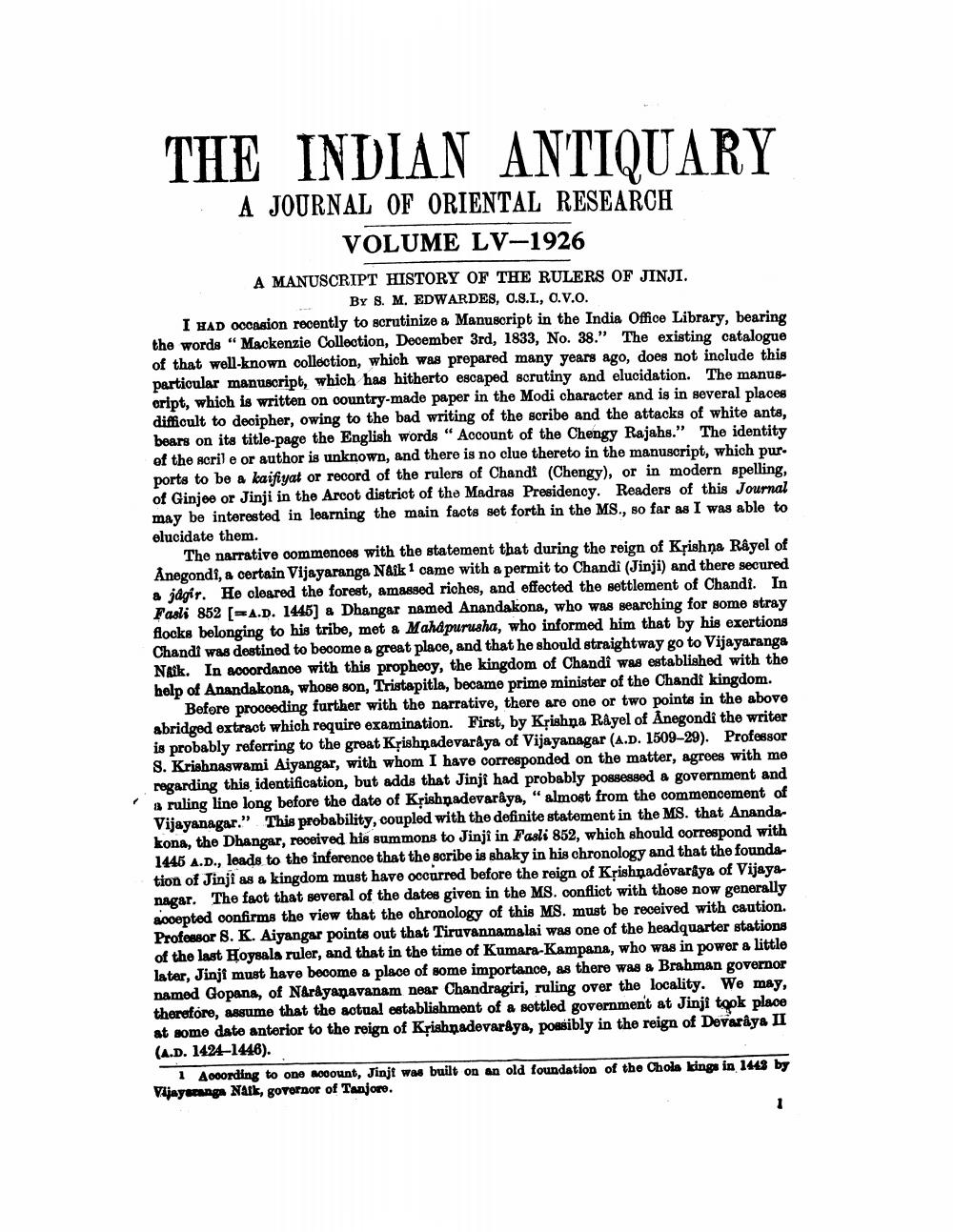Book Title: Indian Antiquary Vol 55 Author(s): Richard Carnac Temple, Stephen Meredyth Edwardes, Krishnaswami Aiyangar Publisher: Swati Publications View full book textPage 7
________________ THE INDIAN ANTIQUARY A JOURNAL OF ORIENTAL RESEARCH VOLUME LV-1926 A MANUSCRIPT HISTORY OF THE RULERS OF JINJI. BY 8. M. EDWARDES, O.S.I., O.V.o. I HAD Occasion recently to scrutinize a Manuscript in the India Office Library, bearing the words " Mackenzie Collection, December 3rd, 1833, No. 38." The existing catalogue of that well-known collection, which was prepared many years ago, does not include this particular manuscript, which has hitherto escaped scrutiny and elucidation. The manusoript, which is written on country-made paper in the Modi character and is in several places difficult to decipher, owing to the bad writing of the scribe and the attacks of white ants, bears on its title-page the English words "Account of the Chengy Rajahs." The identity of the scril e or author is unknown, and there is no clue thereto in the manuscript, which pur. ports to be a kaifiyat or record of the rulers of Chandi (Chengy), or in modern spelling, of Ginjee or Jinji in the Arcot district of the Madras Presidenoy. Readers of this Journal may be interested in learning the main facts set forth in the MS., so far as I was able to elucidate them. The narrative oommonoes with the statement that during the reign of Krishna Râyel of Anegondi, a certain Vijayaranga Naik 1 came with a permit to Chandi (Jinji) and there secured a jágír. He cleared the forest, amassed riches, and effected the settlement of Chandi. In Fasli 852 A.D. 1445) a Dhangar named Anandakona, who was searching for some stray flocks belonging to his tribe, met a Maha purusha, who informed him that by his exertions Chandi was destined to become a great place, and that he should straightway go to Vijayaranga Naik. In acoordance with this propheoy, the kingdom of Chandî was established with the help of Anandakona, whose son, Tristapitla, became prime minister of the Chandi kingdom. Before proceeding further with the narrative, there are one or two points in the above abridged extract which require examination. First, by Krishna Rayel of Anegondi the writer is probably referring to the great Krishnadevaråya of Vijayanagar (A.D. 1509–29). Professor S. Krishnaswami Aiyangar, with whom I have corresponded on the matter, agrees with me regarding this identification, but adds that Jinji had probably possessed a government and a ruling line long before the date of Krishnadevaraya, “almost from the commencement of Vijayanagar.” This probability, coupled with the definite statement in the MS. that Anandakona, the Dhangar, received his summons to Jinji in Fasli 852, which should correspond with 1445 A.D., leads to the inference that the scribe is shaky in his chronology and that the founda tion of Jinji as a kingdom must have occurred before the reign of Krishnadevar ya of Vijaya nagar. The fact that several of the dates given in the MS. conflict with those now generally socepted confirms the view that the chronology of this MS. must be received with caution. Professor 8. K. Aiyangar points out that Tiruvannamalai was one of the headquarter stations of the last Hoysala ruler, and that in the time of Kumara-Kampana, who was in power a little later, Jinji must have become a place of some importance, as there was a Brahman governor named Gopana, of Narayanavanam near Chandragiri, ruling over the locality. We may, therefore, assume that the actual establishment of a settled government at Jinji took place at some date anterior to the reign of Krishnadevaraya, possibly in the reign of Devaraya II (A.D. 1494-1446). 1 According to one account, Jinjt was built on an old foundation of the Chola kings in 1443 by Vijayaranga Naik, governor of Tanjore.Page Navigation
1 ... 5 6 7 8 9 10 11 12 13 14 15 16 17 18 19 20 21 22 23 24 25 26 27 28 29 30 31 32 33 34 35 36 37 38 39 40 41 42 43 44 45 46 47 48 49 50 51 52 53 54 55 56 57 58 59 60 61 62 63 64 65 66 67 68 69 70 71 72 ... 370
